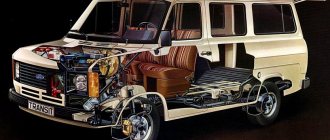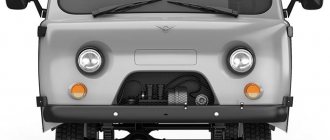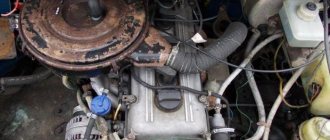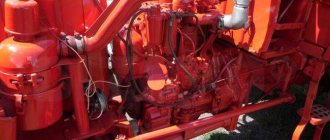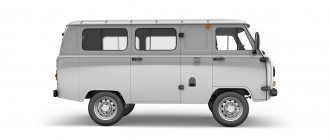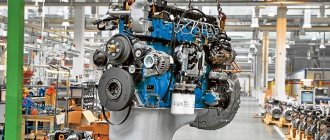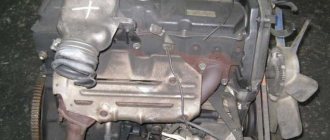In 2016, the Ulyanovsk plant announced the next update of a time-tested car (UAZ 3909, etc.). During the time that has passed since the production of the first UAZ 451 M, various power units of both the Ulyanovsk (UMZ) and Zavolzhsky (ZMZ) motor plants were installed on these cars. It is believed that the base engine of the UAZ loaf is the UMZ 421 gasoline engine, various modifications of which (carburetor and injection) are produced to this day.
UAZ 452 (loaf) is one of the oldest cars, various modifications of which are produced by the Ulyanovsk Automobile Plant to this day. On the basis of this all-wheel drive minibus, commonly known as a “loaf” or “tablet” (army nurse), mass production of which began in 1965 (UAZ 451M), a large number of different modifications were developed. It has been modernized several times and is still produced in an updated form (UAZ 2206).
About engines for the UAZ 3303-“Loaf” truck
The cargo model 3303 from the Ulyanovsk Automobile Plant is one of a series of all-wheel drive utility vehicles, which also includes a van, a minibus, a medical vehicle and a carriage-type model (Farmer).
Popularly nicknamed “Loaf”, the model has been traveling around the Russian expanses for more than half a century, and under the hood it has evolved GAZ-21 engines. Some modifications of power units are now being installed on the UAZ Hunter and Patriot. Engine UMZ 417 / 4175 / 4178 2.45 l
The next step in improving the GAZ-21 engine was the UMZ 417 engine with a compression ratio increased to 7, a modified camshaft, new 47 mm intake valves, with old exhaust valves. The UMZ 417 also received a two-chamber carburetor and a new air filter. Later, these engines began to use a crankshaft without packing.
If we compare the UMZ 417 with the ZMZ 402, their differences will be cosmetic: on the 417s there are no stiffeners, the liners are softer, and the flywheel is larger, while the principle of operation of the cooling system is inverted.
A different intake manifold and smaller exhaust valves affect engine power.
Engine malfunctions are completely similar to the disadvantages of the ZMZ 402, that is, there are extraneous noises and knocks, the need to adjust valves every 10 thousand kilometers, overheating, etc.
Vibrations and jerking occur due to the curved design, resulting in uneven fuel delivery.
Experts consider the UMZ 417 engine to be outdated, like other units from the GAZ-21 family, and they have no place under the hood of modern cars. 1
Engine UMZ 421 / 4213 / 4215 / 4216 / 4218 2.9 l
The UMZ 421 power unit became the most modern modification of the GAZ-21 engine and a logical development of the UMZ-217 model, but with a larger volume and exhaust valves increased to 39 mm. The newest versions of the UMZ 421 already have a fuel injection system installed.
The UMZ 421 engine differs from the ZMZ 402 in thin dry liners, which increased the strength of the block, cylinders 100 mm in diameter, and the pistons have pins offset by 7 mm. Instead of anachronistic padding, a rubber cuff and other small parts are used.
At the same time, on a global scale, the engine has not changed and is essentially the same unit from the mid-50s, but in an improved form.
Due to the lack of hydraulic compensators, the gaps will have to be adjusted every 10 thousand kilometers.
The disadvantages of UMZ 421 include a crooked design, which affects the occurrence of twitching, vibrations, and other things.
Engine knocking occurs due to unadjusted valves, connecting rod bearings or camshaft.
Overheating of the engine occurs due to a defect in the thermostat, pump or air lock in the cooling system.
The advantages of the UMZ 421 include high-torque power, availability of spare parts and full maintainability. If you take care of the engine and do not overload it, the service life will be at least 200 thousand kilometers.
Engine ZMZ 409.10 / 4091.10 / 4092.10 / 4094.10 2.7
The basis for the large-volume ZMZ-409 engine was the ZMZ-405, which used a crankshaft with a stroke increased to 94 mm, the same connecting rods, and modified pistons shifted by 4 mm. Otherwise, it’s still the same 405 with the same cylinder block height, thinner inter-cylinder bridges, and slots for cooling. Torque has increased due to increased performance by 7 “horses,” and the latest engine modifications comply with Euro-3 eco-standards.
Maintenance of carburetor K-126G
Maintenance of the device boils down to cleaning and adjusting it. As for the frequency of such work, it should be carried out at least once a year, as well as when signs of device malfunction are identified.
Cleaning the carburetor involves the following activities:
- external cleaning of dirt, dust, oil deposits of the throttle assembly, float chamber housing and cover;
- washing and purging of nozzles, atomizer, fuel filter, emulsion tubes, holes and channels of the device;
- cleaning air and throttle valves.
Carburetor adjustment involves setting:
- fuel level in the float chamber;
- cold start systems;
- idle systems.
To carry out complete maintenance, it is recommended to remove the carburetor from the engine and disassemble it.
Dismantling the K-126G carburetor
- set of wrenches;
- Screwdriver Set;
- clean dry cloth.
Work order:
- Remove the air filter from the carburetor. Depending on the modification of the engine and the car itself, it may have a different design and different mountings. It is usually secured with a rubber hose and clamp.
The air filter is usually attached to the carburetor using a rubber hose and clamp.
The fuel hose is secured with clamps
The vacuum hose transmits vacuum from the intake pipe to the ignition timing regulator
The cable is secured with two screws: the first secures the braid, the second fixes the core
To remove the drive rod, you need to unscrew the nut securing it
To dismantle the carburetor, you need to unscrew the 4 nuts securing the device to the intake pipe
After dismantling the carburetor, you need to close the holes in the intake pipe
Removing the float chamber cover and disconnecting the throttle assembly
In order to disassemble the device, it is necessary to disconnect the cover from the float chamber body, and then the mixing chamber housing.
Work order:
- Unsplint the upper end of the economizer drive rod. Disconnect the rod.
- Using a screwdriver, unscrew the 7 screws securing the cover to the float chamber body.
To remove the cover you need to unscrew 7 screws located around its circumference
To remove the cover, you need to carefully pry it off with a thin slotted screwdriver.
Do not place the lid with the float down: the adjustment of the float mechanism will be disrupted.
The float chamber cover must not be placed with the float down.
The carburetor throttle assembly is disconnected from the float chamber body by unscrewing 4 screws (the caps are located at the bottom).
Video: disassembling the K-126G carburetor
Carburetor cleaning
In order to clean the carburetor, you must:
- Unscrew the plug and remove the strainer.
The carburetor filter collects all the dirt found in gasoline.
Before cleaning, all carburetor parts must be soaked in kerosene.
Carburetor assembly
After cleaning, the device can be assembled. Before doing this, it is worth assessing the condition of the gaskets and, if necessary, replacing them. The device is assembled in the reverse order, i.e., first all the small parts that have been cleaned are put in place, and then the float chamber is connected to the housing of the mixing chambers. The lid is screwed on last.
Device installation
Having completed the assembly, install the carburetor on the engine. Pay attention to the condition of the gasket and the orientation of the device. Do not turn the gasket over to eliminate deformation. It's better to replace it immediately.
When tightening the nuts securing the device, do not overdo it. If you use excessive force, you can break the threads on the studs and also deform the carburetor mating plane.
After installation, the hoses (fuel and vacuum) are connected, and the air damper drive cable and the throttle control rod are connected.
Setting up the K-126G carburetor
First of all, the float mechanism is adjusted. It allows you to set the required level of gasoline in the chamber. Work order:
- We place the car on a level area.
- We start the power unit and warm it up to operating temperature.
- We turn off the engine and use a ruler to measure the level of gasoline in the float chamber. We take measurements through a special window. The level should be between 18.0–20.5 mm.
- If the level does not correspond to these indicators, remove the cover of the float chamber and bend the float mounting tab in one direction or another. At the same time, we ensure that the distance from its upper plane to the plane of the camera connector is 40–41 mm.
After this, you can begin setting up the cold start system. The main element here is a semi-automatic damper that shuts off the air supply. Its mechanism is connected through rods and levers to the drive mechanism of the primary chamber damper and automatically opens it when launched to the desired angle.
The damper should be fully open when the control handle is recessed, and closed when it is extended. If it closes and does not open completely, you need to adjust its position by adjusting the length of the rod. After adjustment, you need to make sure that the cable moves freely and does not jam.
The final stage of adjustment is to adjust the engine idle speed. It is carried out by rotating a screw that regulates the opening angle of the throttle valve of the primary mixing chamber, as well as another screw that regulates the enrichment and depletion of the combustible mixture.
The number of crankshaft revolutions of a power unit idling at an operating temperature of 80–900C should be 450–550 rpm.
The idle speed is adjusted using a tachometer. If the design of the car does not provide for such a device, you can use a car tester with its function, or a stand-alone tachometer. The positive probe of the device is connected to terminal “K” of the ignition coil, and the negative probe is connected to the “ground” of the car.
Procedure for adjusting idle speed:
- We connect the tachometer.
- Without starting the engine, fully tighten the mixture adjustment screw, but do not tighten it, and then unscrew it 2.5 turns.
- We start the power unit, warm it up to a temperature of 80–90 0 C, and use the screw that regulates the opening angle of the throttle valve to set the minimum speed.
- Use the quality screw to set the speed at 600 rpm.
- We check whether the engine stalls or “chokes” when you sharply press the accelerator pedal.
- Use the first screw to reduce the speed to 450–550 rpm.
Available and proven diesel engines for UAZ Bukhanka (UAZ 452)
1. First on the list is a diesel unit from Ford, namely the 2.4-liter Sierra model, which was produced from 1984 to 1990. And the second model is the Ford Scorpio with a volume of 2.5 liters, which was produced from 1984 to 1990. By the way, engines from American car brands serve very well and last a long time. Both diesel engines presented are ideal for replacing the original gasoline engine from UAZ Bukhanka. Fitting these engines will not be difficult, both for experienced craftsmen and folk craftsmen.
2. The second brand of cars whose diesel engines are widely used in the UAZ Bukhanka are diesel engines from Mercedes. Power units with a volume of 2 and 2.4 liters, which were produced from 1980 to 1984. It is worth noting that the price of a UAZ Bukhanka with a Mercedes diesel engine remains one of the highest in the line.
It is also necessary to take into account the following nuance - in all Mercedes diesel engines, the oil filter is located extremely impractically and unsafely, namely at the very bottom of the engine, just towards the traffic. It is for this reason that it is strongly recommended to install additional protection on the engine, otherwise there is a high risk of damaging the oil filter directly when hitting a hole or bump.
3. The famous Isuzu model, namely the 4JG2 series of diesel units, has become very popular for the UAZ Bukhanka. The engine capacity is an impressive 3.1 liters with supercharging. But this type of engine remains inaccessible due to its rarity, since not so many such cars have been sold over the years.
4. And the last of our list, proven by time and the most severe weather conditions, is the power unit from Toyota. Installing a diesel engine on a UAZ Bukhanka with a volume of 2.4 liters from the Xac 2L model is especially popular. Excellent technical characteristics, availability and reliability distinguish this unit from other competitors. It is for these reasons that we will dwell on the Toyota engine in more detail.
Installation of a diesel engine on a UAZ Bukhanka
In order to accurately and correctly fit a diesel engine in place of a gasoline UAZ Bukhanka, you will need a special adapter. This device is designed to connect the clutch directly to the gearbox.
The remaining components of the car, for example, the transmission, will not need to be modified. It will be necessary to make some changes to the operation of the on-board electrics, as well as improve the car’s power system.
Replacing a gasoline engine with a UAZ 452 diesel (step-by-step process)
1. First of all, we need to completely remove the gasoline engine, and also cut off the brackets with a grinder, in place of which we will weld new ones.
2. After this, we hang the new diesel engine on a hoist, where the brackets have already been cut from the frame. You should carefully ensure that the diesel ratchet (bolt) is strictly directed into the hole in the crank handle, which is located in the frame.
3. It is best to install cushions on an engine from a UAZ, which is much cheaper than the original ones from Toyota. But in this case, they will need to be modified so that there is no unnecessary vibration. On the UAZ Bukhanka, the diesel engine must be installed without a head - it’s much simpler.
4. Then we move on to remaking the intake pipe and cut off the pan from the Toyota diesel engine, as well as the bottom from the Volgov or UAZ pan and weld it all together onto the diesel engine being installed. It is better to clean the seams and process them with cold welding.
5. UAZ Bukhanka diesel, the price of the engine from Toyota Xac 2L starts from 16,874 rubles. After installing the engine and crankcase, we begin adjusting the clutch. To do this, you can take the universal UAZ, which should fit us in 3 holes. We will drill and tap everything else 3.
6. Next, instead of the bearing directly under the input shaft, we can grind a bronze bushing, but we should not grind the original crankshaft under the bearing from the UAZ.
7. It is best to buy two narrow bearings 35x17 and 7 mm thick, and insert them into a U-shaped machined bushing one after the other. Then we press it into the crankshaft.
Some UAZ Bukhanki diesel car enthusiasts advise making noise insulation under the hood, since the diesel engine is much louder than the original gasoline engine. You will also need to cut a little of the blade on the cooling fan and make a fitting for the oil sensors. That's all the modifications that need to be done.
Which engine is better for UAZ: gasoline or diesel?
The cars of the Ulyanovsk Automobile Plant are the best SUVs of the Russian automobile industry, which have won enormous popular love, which also makes car owners interested in the question: which engine is better to choose for a UAZ car so that it is guaranteed to serve for a long time and reliably, withstand difficult operating conditions and off-road driving.
In this article we will look at the features of each engine, their main differences, advantages and disadvantages, and you can make a final conclusion and decide for yourself which engine is better.
UAZ Bukhanka (diesel) – economical SUV
The people's all-terrain vehicle UAZ Bukhanka (Tabletka) has become popular due to its technical and driving characteristics. A reliable, time-tested car has become the best in its class for fans of fishing, hunting, residents of villages, villages and hard-to-reach places. But besides the gasoline version of the model, there is also a UAZ Bukhanka diesel, which is characterized by efficiency and excellent traction.
The power units that were mass-produced for the UAZ Bukhanka were exclusively gasoline, but diesel versions of the popular all-terrain vehicle were also available for the military by special government order.
The principle of a gasoline engine
To decide whether to choose diesel or gasoline, consider the operating principle of a gasoline engine. It is well known to many car owners: it is an internal combustion engine, in the cylinders of which the compressed fuel mixture is ignited by an electric spark. Power control in most cases is accomplished by regulating air flow using the throttle valve.
The design, as well as the individual characteristics of the gasoline engine of the UAZ Patriot, determine its advantages and disadvantages.
There are several of its disadvantages:
- Relatively weak power at low revs. Even a seemingly powerful engine with 127 hp. does not make it possible to use all these horsepower at low speeds, on the other hand, the car picks up speed well and quickly accelerates to 100 kilometers.
- Demanding on fuel quality. Gasoline with an octane number of at least 92 is suitable for refueling, which is why operating the car and engine becomes quite expensive, especially in the face of constantly rising gasoline prices.
- Rapid wear. During operation, engine parts are exposed to strong temperature effects, which lead to increased wear and faster failure.
Of course, when deciding for yourself whether diesel or gasoline is better, you cannot look only at the disadvantages of the engine, because it also has advantages:
- a gasoline engine is almost 100 thousand cheaper than a diesel engine;
- quick warm-up even in extreme cold;
- low engine noise at idle.
Signs of a carburetor malfunction
Like any other mechanical device, a carburetor cannot operate without failure all the time. The reasons for this may be:
- clogging of jets and channels;
- wear of gaskets or seals;
- violation of regulations of systems and mechanisms.
Symptoms that the carburetor is operating in emergency mode include:
- unstable idling (floating speed);
- inability to start or complicated starting of the power unit;
- reduction in engine power;
- jerks when starting from a standstill, as well as failures during acceleration;
- increased fuel consumption;
- detonation.
Naturally, the above signs may indicate other problems in the fuel system or ignition system, but flushing, cleaning and adjusting the carburetor will not harm it in any way.
How to identify a possible malfunction
To determine a possible carburetor malfunction, use the table.
Table: main malfunctions of the K-126G carburetor
| Signs | Possible faults |
| The power unit does not start at all. Gasoline is observed to leak from under the float chamber gasket. | The engine starting system is not adjusted. The carburetor overflows fuel due to a maladjustment of the float mechanism (level too high). |
| The engine starts after several attempts, but periodically stalls. | The carburetor filter is clogged. The quality of the mixture has not been adjusted. |
| The engine shoots or "sneezes" into the carburetor. | The float mechanism is not adjusted correctly (level too low). The quality of the fuel mixture is incorrectly adjusted (lean mixture). |
| The power unit is unstable only at idle, while the speed “floats”. | The fuel jet of the idle system is clogged. The mixture quality control is broken (lean mixture). |
| There is a decrease in the power qualities of the power plant. Detonation occurs under load. | Fuel jets are clogged. Problems with the accelerator pump. The fuel mixture is too lean. |
| There are jerks at start, dips when pressing the gas pedal. | The accelerator pump is faulty. The carburetor strainer is clogged. The quality of the fuel mixture has not been adjusted (too lean). |
| Increased fuel consumption. | The fuel level in the float chamber is incorrectly adjusted (too high). The adjustment of the cold start system is broken (the air damper does not open completely). Air jets are clogged. The amount of incoming fuel is incorrectly adjusted. |
How does a diesel engine work?
Now let's look at the UAZ Patriot diesel engine.
To an inattentive observer, it may seem that gasoline and diesel engines are practically no different from each other, but they have radically different ways of forming and igniting the fuel-air mixture. In a diesel engine, the fuel ignites due to the high temperature of the air in the cylinder.
The working process looks something like this: air enters the cylinder, heated to almost 1000 degrees due to the high degree of compression. Fuel is injected into the combustion chamber under high pressure, which mixes with heated air and ignites. This mechanism is characterized by a noisy start-up, but allows you to effectively ignite cheap fuel and lean mixtures.
How the K-126G carburetor works
The carburetor consists of three main elements:
- throttle assembly (mixing chamber housing);
- float chamber;
- covers.
K-126G has two chambers for mixing fuel with air. The first works in all modes, and the second only at high loads, when the first throttle opens more than 2/3 of the stroke.
The cover of the device contains an air damper with a drive mechanism, as well as a float mechanism. The float chamber contains diffusers, fuel and air nozzles, an accelerator pump, and emulsion tubes. The throttle assembly has dampers (one in each chamber) and adjusting screws. In addition, there is a transition hole for the idle system, as well as channels for air and fuel.
The K-126G design includes the following systems:
- cold start;
- idle move;
- dosage.
It also contains the following components and mechanisms:
- float mechanism (float, float axis, needle valve);
- economizer (valve, nozzle, drive mechanism);
- accelerator pump (piston, intake and exhaust valves, drive mechanism).
The K-126G carburetor has a two-chamber design with alternate opening of the throttle valves
Digital designations for the K-126G carburetor diagram
- Acceleration pump.
- Main air jet of the secondary chamber.
- Small diffuser of the secondary chamber.
- Balancing channel.
- Economizer sprayer.
- Air damper.
- Acceleration pump nozzle.
- Discharge (discharge) valve.
- Rocker mechanism of the air damper.
- Idle air jet.
- Small diffuser of the primary chamber.
- Main air jet of the primary chamber.
- Fuel valve.
- Fuel filter.
- Float.
- Viewing window.
- Drain plug.
- Main fuel jet of the primary chamber.
- Emulsion tube of the primary chamber.
- Throttle valve drive lever.
- Throttle valve of the primary chamber.
- Idle passage hole.
- Mixture quality adjustment screw.
- Idle fuel jet.
- Secondary chamber throttle valve.
- Large diffuser.
- Secondary chamber emulsion tube.
- Main fuel jet of the secondary chamber.
- Check (inlet) valve.
Specifications
Send by email
| PARAMETER | MEANING |
| Cylinder block material | aluminum |
| Cylinder displacement, cm. cubic meters. | 2890 |
| Rated power (at a crankshaft speed of 4000 rpm), l. With. | 98…125 |
| Maximum torque (at a crankshaft speed of 2500 rpm), Nm | 220 |
| Number of cylinders | 4 |
| Cylinder diameter, mm | 100 |
| Piston stroke, mm | 92 |
| Compression ratio (depending on modification) | 7,0…8,8 |
| Number of valves per cylinder | 2 |
| Cylinder Sequence | 1 -3- 4 — 2 |
| Supply system | Carburetor (UMZ-421.10, UMZ-4218); Injector (UMZ-4213, UMZ-4215, UMZ-4216). |
| Fuel type/brand | gasoline/A-76, A-92 |
| Fuel consumption, l/100 km (highway/mixed) | 42684 |
| Lubrication system | Combined (pressure + spray) |
| Engine oil volume, l | 5.8 |
| Engine oil type | 5W-30, 5W-40, 10W-30, 10W-40, 15W-40 |
| Cooling system | Liquid, closed type, with forced ventilation |
| Weight, kg | 170 |
| Motor resource, thousand km | 250 |
The engine was installed on GAZ Gazelle, GAZ Sobol, UAZ “Loaf”, UAZ Simbir, UAZ Hunter, UAZ Bars, etc.
How the diesel engine was created on the UAZ
For the first time, within the walls of the Ulyanovsk Automobile Plant they started talking about a diesel engine back in 1978, when many modern car enthusiasts were just being born, and others had not been around for a very long time.
Initially, work on creating the engine was carried out simply to create a new version of the engine; they did not see any special prospects in it. However, in the 90s, when a large number of foreign cars with diesel engines appeared on the domestic car market, our customers were able to appreciate their parameters, in particular, the ability to refuel the car with cheap fuel.
The main differences between a diesel engine and a gasoline engine
We have already talked about the main difference in the ignition of the fuel-air mixture in UAZ Patriots on gasoline and diesel, about performance, cost and consumption, too, but there is another indicator that is recommended to be considered today, and this is environmental friendliness.
Oddly enough, diesel engines are considered much more environmentally friendly, as they emit fewer harmful substances into the environment than gasoline engines.
Because of this, they have become widespread in countries where concern for the environment is gradually coming to the fore. These include not only Europe, but also many Asian countries and America.
How to install a diesel engine on a gasoline UAZ
So which engine is better, diesel or gasoline? Many people choose diesel because of its efficiency, environmental friendliness and lower consumption. Some even manage to install diesel engines on their originally gasoline cars.
It is quite difficult to do this and it is better to first consult with real professionals in this matter, who will be able to tell you how to make an adapter for a diesel engine, how and which unit is best to install. Some manage to install engines from Mercedes and other Western cars on their old “Loaves”. There are such monsters walking around, oddly enough, it’s wonderful in Russia.
Malfunctions and repairs
Basic malfunctions of the Bukhanka engine. Let's consider what main problems motorists will have to face during the operation of the UMP and ZMZ power units:
Repair of the UAZ engine is carried out by analogy with the ZMZ 402, since it is a structural copy.
The motor is quite easy to repair even in the worst technical condition. Thus, the power unit, the block head and the replacement of consumables are being overhauled. The repair process itself is carried out in stages, as for any power unit.
Tuning
Tuning the UMZ 421 engine comes down to organizing turbocharging. Setting a quiet urban mode will not only increase the power of the power unit, but will improve the torque characteristics. For this it is enough:
- Modify the cylinder head by grinding the combustion chambers and channels.
- Install a Garrett 17 with an intercooler, making a corresponding manifold.
- Replace standard injectors with Subaru 440 cc injectors.
- Dismantle the existing exhaust into a direct-flow exhaust made on a 63 pipe.
- Configure the entire system.
One type of tuning is the installation of a diesel engine on the UAZ 452 “Loaf”. In this case, it is necessary to clearly understand which engine to install in the car. Most often, “traditional craftsmen” from among car enthusiasts who own a “loaf” install foreign-made diesel engines on it, among which are motors from cars:
- FORD: DAF-400 or Indenor XD2P Peugeot with a cylinder capacity of 2.3 - 2.5 liters;
- Mercedes-Benz: OM-616, OM-617, having a cylinder volume of 2.2 to 3 liters;
- Isuzu: 4JG2 with an impressive cylinder capacity of 3.1 liters + turbocharging;
- Toyota: 2L, the cylinder capacity of which is 2.4 liters.
Answering the question: “Which engine to install in a loaf minibus,” many choose the 2L power unit from the Toyota Hiace. Its installation is simple and can be done in almost any garage that has a welding machine.
It is also easy to install the DAF 400 engine from Peugeot, which was once installed on Volga 21 cars in export version. This diesel engine fits the UAZ perfectly and is installed without any problems at all, except for the fact that getting it is quite problematic.
Based on my own experience, I’m talking about the UAZ “Bukhanka” car.
This year marks 54 years since the first production car UAZ-452 rolled off the assembly line, which was popularly nicknamed “Loaf”, “Tablet”.
For some time in my life I had to work on the UAZ “Bukhanka” car on its various modifications, which is why I will not dwell on any one modification of the “Loaf”, I will try to leave my review of the model in general.
About breakdowns.
The car is simple and unpretentious to maintain; the frequency of breakdowns directly depends on the frequency of time spent on maintenance. In my experience, there were no breakdowns that could stop this car; even when it was “knocked out in battle,” it took me and the brigade to the base.
About versatility.
In addition to working in a car, we often went to cultural events; the large interior allows us to place a table in the center, and the off-road capabilities allow us to drive into the outback with a beautiful landscape. After lengthy preventive measures, believing in the passable quality of the UAZ, we spent a long time looking for a tractor.
Salon
The car presented in the article has an updated interior appearance. I had a slightly different salon. The main update is the new dashboard, which has moved to the central part. This layout of the instruments looks nice, now passengers can monitor the instrument readings and inform the driver if emergency situations arise.
A little about engines.
At the beginning of my driving practice, I drove a UAZ with a ZMZ-402 engine (98 hp) with a consumption of 16 liters per hundred kilometers. It is worth immediately noting its short motor life: in difficult conditions, the engine lasted for about 100 thousand kilometers, then various kinds of problems began to arise, ranging from oil wastage to low pressure in the engine lubrication system when it was hot. But with the arrival of ZMZ-409 the situation has changed radically. Engine power increased to 112 hp. Fuel consumption on the highway decreased to 10.5 liters per hundred kilometers, and the engine's service life increased by almost two and a half times.
Modifications
Based on the standard UAZ-452, many different modifications have been developed, differing mainly in technical characteristics and some design features. The entire line of modifications is represented by the following versions:
- Modification of UAZ-452A. It is an ambulance. Four stretchers or eight patients can be placed inside on folding benches. In addition to all this, there is also room for one accompanying person. The total passenger capacity of this modification is 11 people. Despite the fact that this is an ambulance used to transport patients, the level of comfort is still very low. This is explained by the fact that the manufacturer left the suspension without any changes. However, this did not reduce the popularity of the model, since due to its excellent off-road qualities, the UAZ-452A remains the only ambulance capable of coping with quite complex road obstacles. The entire internal space is divided by a partition into two parts, namely the driver’s and sanitary compartments. The sanitary compartment has folding seats and fastenings on which stretchers are installed. Also, in addition to this, the car can be equipped with special medical equipment. A small turning headlight can be installed on the roof at the front.
- Modification of UAZ-452AS. It is a special ambulance vehicle designed for operation in harsh climates, such as, for example, in the northern regions;
- Modification of UAZ-452AE. It is a universal purpose chassis. The modification can be equipped with various additional add-ons and specialized equipment;
- Modification of UAZ-452V. It is a minibus with a carriage body. The cabin of this version is designed for 10 passengers;
- Modification of UAZ-452D. It is a truck with a two-seater all-metal cabin and an onboard cargo platform made of wood. This version was popularly nicknamed “tadpole” due to its similar appearance;
- Modification of UAZ-452G. It is an ambulance with an expanded interior and an increased number of seats;
- Modification of UAZ-452K. It is an experimental bus using a three-axle platform with a 6x4 wheel arrangement. The cabin of this modification can accommodate up to 16 passengers. A version was first introduced in 1973, but was never mass produced. The Ulyanovsk Automobile Plant produced only a small batch;
- Modification of UAZ-452P. It is a very rare example, created on the basis of the standard UAZ-452. This version is a truck-type tractor.
Offers for UAZ-469
Diesel engines suitable for the “Loaf”, in principle, are also installed on the “goat”. True, more alterations will be required.
It is considered the most practical to replace the gasoline unit with something from ZMZ-406, ZMZ-405, ZMZ-409
with injector. You will have to deal with the engine mount, its exhaust system, and the fuel system; You will need to redo the clutch housing and deal with the wiring. But this is the cheapest option.
Mercedes engines OM616 and OM617
– time-tested, reliable and relatively economical.
With Toyota it is better to install the 1KZ-TE
. There will be enough alterations, but you won’t have to touch the body. And if you want to avoid numerous reworkings, take a 2LT diesel from the Toyota Surf
: there you only need to grind a 2-centimeter spacer under the front driveshaft and move the radiator forward a little.
Unlike the “loaf”, where you need to cut half of the body, the 469 can also be supplied with Nissan’s TD-27
. True, it is heavy and noisy - the cylinder block and head are cast iron. But reliability is almost the highest of all options. In fact, this is not the entire list of which diesel engine is suitable for the UAZ-Bukhanka and 469. We have listed only the most successful (according to the majority) options. If you want, you can put something else.
Story
The history of this car begins back in the 1950s. Then the designers of the Ulyanovsk Automobile Plant were faced with the task of developing a larger and load-lifting universal platform, on which it was planned to build flatbed trucks and all-metal vans in the future. Moreover, both planned versions must have high cross-country ability.
In the process of developing a new car, the Ulyanovsk Automobile Plant took the model of the Gorky Automobile Plant GAZ-69 as a basis, since it had excellent off-road qualities.
In 1958, the designers presented their first experimental prototype, which received an extended base and chassis of the GAZ-69 truck. It is worth noting that many design solutions and units were borrowed. Upon completion of the tests, mass production of new all-wheel drive vehicles was organized, which received the factory index UAZ-450. As planned, the UAZ-450 was produced as an all-metal van, an ambulance, and a flatbed truck.
Later, a modification of the UAZ-451 appeared, which is a further development of the 450th model. Unlike its predecessor, this model had only rear-wheel drive. But the maximum carrying capacity was increased to 1000 kilograms. For modification, more powerful power plants with overhead valves were offered, which were also developed at the Ulyanovsk plant. These engines were paired with an improved four-speed manual transmission.
In addition to the technical component, the designers also redesigned the appearance with which modern modifications are still produced.
The rear-wheel drive modification of the UAZ-451, which for several years was produced simultaneously with the UAZ-452, was also offered to consumers in the form of an all-metal van, an ambulance and a flatbed truck with a double cabin and a wooden loading platform.
In 1965, the UAZ-450 model was significantly modernized. The body was equipped with a side door, which turned the cargo van into a utility vehicle. A double door was also installed at the rear. Depending on the modification and purpose, the car could have different configurations of the location and design of the doors. This year's modernization also affected the power unit used and many transmission elements. As a result of all the improvements, the new model was assigned the factory index UAZ-452.
Nowadays, modern models of “loaves”, “tablets” and “tadpoles”, despite the same appearance, use injection power plants that meet Euro-4 environmental requirements, an ABS anti-lock braking system, and hydraulic power steering. Although the UAZ-452 was discontinued in 1985, all its subsequent modifications continued the story, but under different factory indices.
UAZ Bukhanka: description, engines, automatic transmission, technical characteristics
UAZ Bukhanka is a Russian all-wheel drive vehicle designed for transporting people and goods in off-road conditions. Produced since 1965 at the Ulyanovsk Automobile Plant. The founder of the car series is the UAZ-452. Newer versions of the model are actually modifications of it. The car has many body options - minibus, van, truck, tractor unit, 16-seater bus and others. Since 2011, cars have been produced in accordance with Euro 4 standards.
Engine UMZ-417
The UMZ-417 engine is another step in the evolution of the GAZ-21 engine, replacing the UMZ-414 engine, from which it differs in an increased compression ratio from 6.7 to 7, a different camshaft, enlarged intake valves to 47 mm (was 44 mm), old exhaust valves 36 mm, a two-chamber carburetor and another air filter are installed. In later modifications, a crankshaft from UMZ-421 without packing was used. Read more about the UMZ-417 engine...
Engine ZMZ-409
ZMZ 409 is an injection gasoline engine with 4 cylinders in an in-line layout and 16 valves. In the 409 engine, the injector system is controlled by a microprocessor electronic unit. This motor was put on the conveyor in 1996. This engine was mainly installed on new and modern domestic UAZ and GAZ cars. The entire generation of these power plants is equipped with a gas neutralizer and is manufactured entirely in accordance with EURO-2 standards. Read more about the ZMZ-409 engine...
Engine UMZ 421
The UMZ-421 engine replaced the 417 engine, which has established itself as a reliable and simple engine. The 421 uses an original design of an aluminum frame, in which dry liners with thin, cast-iron walls are filled. This made it possible to increase the cross-section of the chambers to 100 mm and leave the same size between the cylinders of 116 mm. The solution had a positive effect on the service life, since rigidity increased and the tendency of the cylinders to become “oval” during operation decreased. Read more about UMZ 421 engine...
Description
Like most UAZ car engines, the UMZ 421 engine is a classic in-line 4-cylinder power unit, the cylinder block of which is made of aluminum. Structurally, it is a modern representative of the model range of power units, originating from the GAZ 21 engine produced by UMZ. This model range includes power units UMZ 451, UMZ 414, UMZ 417 and UMZ 421 with a lower camshaft. These motors do not have significant design differences and at one time each of them was installed on the UAZ “loaf”.
The prototype of the 421 engine is the UAZ 469 (UMZ 417) engine. It differs from the latter by the larger size of the exhaust valves and increased cylinder capacity. Modifications UMZ 4213...4216 are already injection engines.
Before the advent of the UMZ 421 motor, it was believed that ZMZ engines were more reliable. The line of ZMZ power units, which were also installed on UAZ vehicles, is represented by the ZMZ 24 and ZMZ 402 power units. When developing the UMZ 421, it was possible to eliminate a number of shortcomings inherent in ZMZ engines:
- due to the use of dry thin liners, the strength of the cylinder block has been increased: the volume of the cylinders has been increased, which has made it possible to increase the power of UAZ engines;
- Instead of an oil seal packing for the crankshaft rear oil seal, a rubber cuff is used, which makes it possible to increase and simplify engine maintenance.
These essentially minor changes increased the operational reliability of engines installed on UAZ and changed the attitude of consumers towards UMP products. For example, the Gorky Automobile Plant often installs UMZ injection engines on GAZelle-type vehicles. The same engines power the new series of UAZ and UAZ Hunter light commercial vehicles.
Maintenance of UAZ 421 engines, as well as all other engines of this family, comes down to regular:
- Changing the engine oil every 10,000 km.
- Adjusting the valve clearances of the gas distribution mechanism - after 15 thousand kilometers.
- Check for engine oil and coolant leaks.
